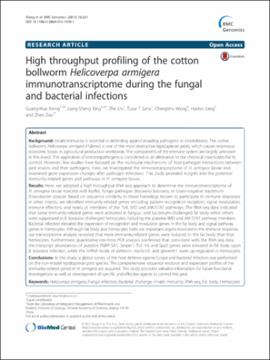| dc.contributor.author | Xiong, Guang-Hua | |
| dc.contributor.author | Xing, Long-Sheng | |
| dc.contributor.author | Lin, Zhe | |
| dc.contributor.author | Saha, Tusar T. | |
| dc.contributor.author | Wang, Chengshu | |
| dc.contributor.author | Jiang, Haobo | |
| dc.contributor.author | Zou, Zhen | |
| dc.date.accessioned | 2019-08-21T22:01:34Z | |
| dc.date.available | 2019-08-21T22:01:34Z | |
| dc.date.issued | 2015-04-18 | |
| dc.identifier | oksd_xiong_highthroughputp_2015 | |
| dc.identifier.citation | Xiong, G., Xing, L., Lin, Z., Saha, T. T., Wang, C., Jiang, H., & Zou, Z. (2015). High throughput profiling of the cotton bollworm Helicoverpa armigera immunotranscriptome during the fungal and bacterial infections. BMC Genomics, 16(1). https://doi.org/10.1186/s12864-015-1509-1 | |
| dc.identifier.uri | https://hdl.handle.net/11244/321210 | |
| dc.description.abstract | Background: Innate immunity is essential in defending against invading pathogens in invertebrates. The cotton bollworm, Helicoverpa armigera (Hubner) is one of the most destructive lepidopteran pests, which causes enormous economic losses in agricultural production worldwide. The components of the immune system are largely unknown in this insect. The application of entomopathogens is considered as an alternative to the chemical insecticides for its control. However, few studies have focused on the molecular mechanisms of host-pathogen interactions between pest insects and their pathogens. Here, we investigated the immunotranscriptome of H. armigera larvae and examined gene expression changes after pathogen infections. This study provided insights into the potential immunity-related genes and pathways in H. armigera larvae. | |
| dc.description.abstract | Results: Here, we adopted a high throughput RNA-seq approach to determine the immunotranscriptome of H. armigera larvae injected with buffer, fungal pathogen Beauveria bassiana, or Gram-negative bacterium Enterobacter cloacae. Based on sequence similarity to those homologs known to participate in immune responses in other insects, we identified immunity-related genes encoding pattern recognition receptors, signal modulators, immune effectors, and nearly all members of the Toll, IMD and JAK/STAT pathways. The RNA-seq data indicated that some immunity-related genes were activated in fungus- and bacterium-challenged fat body while others were suppressed in B. bassiana challenged hemocytes, including the putative IMD and JAK-STAT pathway members. Bacterial infection elevated the expression of recognition and modulator genes in the fat body and signal pathway genes in hemocytes. Although fat body and hemocytes both are important organs involved in the immune response, our transcriptome analysis revealed that more immunity-related genes were induced in the fat body than that hemocytes. Furthermore, quantitative real-time PCR analysis confirmed that, consistent with the RNA-seq data, the transcript abundances of putative PGRP-SA1, Serpin1, Toll-14, and Spz2 genes were elevated in fat body upon B. bassiana infection, while the mRNA levels of defensin, moricin1, and gloverin1 were up-regulated in hemocytes. | |
| dc.description.abstract | Conclusions: In this study, a global survey of the host defense against fungal and bacterial infection was performed on the non-model lepidopteran pest species. The comprehensive sequence resource and expression profiles of the immunity-related genes in H. armigera are acquired. This study provided valuable information for future functional investigations as well as development of specific and effective agents to control this pest. | |
| dc.format | application/pdf | |
| dc.language | en_US | |
| dc.publisher | BioMed Central | |
| dc.rights | This material has been previously published. In the Oklahoma State University Library's institutional repository this version is made available through the open access principles and the terms of agreement/consent between the author(s) and the publisher. The permission policy on the use, reproduction or distribution of the material falls under fair use for educational, scholarship, and research purposes. Contact Digital Resources and Discovery Services at lib-dls@okstate.edu or 405-744-9161 for further information. | |
| dc.title | High throughput profiling of the cotton bollworm Helicoverpa armigera immunotranscriptome during the fungal and bacterial infections | |
| osu.filename | oksd_xiong_highthroughputp_2015.pdf | |
| dc.description.peerreview | Peer reviewed | |
| dc.identifier.doi | 10.1186/s12864-015-1509-1 | |
| dc.description.department | Entomology and Plant Pathology | |
| dc.type.genre | Article | |
| dc.type.material | Text | |
| dc.subject.keywords | infection | |
| dc.subject.keywords | bacterial infections | |
| dc.subject.keywords | immune system | |
| dc.subject.keywords | hemocytes | |
| dc.subject.keywords | fat body | |
| dc.subject.keywords | rna | |
| dc.subject.keywords | receptors, pattern recognition | |
| dc.subject.keywords | buffers | |
| dc.subject.keywords | insecticides | |
| dc.subject.keywords | defensins | |
| dc.subject.keywords | immunity, innate | |
| dc.subject.keywords | gene expression | |
| dc.subject.keywords | larva | |
| dc.subject.keywords | immunity | |
| dc.subject.keywords | signal transduction | |
| dc.subject.keywords | genes | |
| dc.subject.keywords | host-pathogen interactions | |
| dc.subject.keywords | gene expression profiling | |
| dc.subject.keywords | data collection | |
| dc.subject.keywords | real-time polymerase chain reaction | |
| dc.subject.keywords | helicoverpa armigera | |
| dc.subject.keywords | enterobacter cloacae | |
